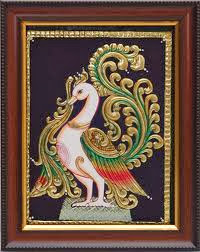Posts in 'Indian Art' series on my blog is my endeavor to bring back the lost charm of various ancient Indian art forms and to let more and more people know about rich culture and heritage of India.
Tanjore or Thanjavur is an age old art form of South India and got its name from 'Thanjavur' a place in Tamil Nadu where this art form originated and it was the capital of Chola Empire. Origin of this art form dates back to 1600AD.
 |
| Image Source: Click Here |
Origin:
Tanjore originated during the reign of 'Nayaks' 'Marathas' and 'Cholas'. Marathas encouraged the art form and it flourished during 16th to 17th century.
Style:
These paintings are very ancient and miniature type of paintings. Paintings mainly consist of a main figure usually deity, figure appears prominent in paintings with well rounded body and cherubic face. Main figure is enclosed in a meticulously crafted enclosure in form of arch or curtain. Paintings are bright and vibrant.
Most striking feature of the paintings are that they are decorated using 22/24 carat gold foil, semi precious stones, cut glasses and pearls to give it a rich look.
 |
| Image Source: Click Here |
Theme:
Theme of the painting is mainly Hindu God and Goddesses, mainly Krishna, Balaji, Lakshmi & Ganesha.
Paintings are bright and faces of main figure are made divine.
 |
| Image Source: Click Here |
Process:
There are several steps involve in making Tanjore painting.
There are several steps involve in making Tanjore painting.
1. Canvas Preparation: Canvas is prepared by pasting a clean cotton/muslin cloth (that is dipped in glue+water solution) on plywood. Let it dry. Now apply a coat of chalk powder paste (Chalk powder + Water + Glue) on canvas and let it dry for a day. Now rub canvas with emery paper to make canvas surface smooth.
2. Choose and then trace the design on canvas using carbon paper.
3. Muck work or embossing: Muck or paste of chalk powder + Arabic gum + glue is then applied on the desired area of the painting using round brush. Let it dry
4. Gem setting or decorating: Now stick stones, gems and pearls on the design and let it dry for a day.
Apply one more layer of embossing paste to make painting more beautiful. use ball pen to make design on embossed areas. Then comes the most important step of the painting, pasting of gold foil on the embossed design. Apply glue on the embossed area and paste gold foil carefully on it and press gently with your thumb, cut the extra part of foil using cutter. Now remove gold foil that is pasted over stones, gems and pearls. You can use any needle like sharp object to remove foil that is over the stones.
2. Choose and then trace the design on canvas using carbon paper.
3. Muck work or embossing: Muck or paste of chalk powder + Arabic gum + glue is then applied on the desired area of the painting using round brush. Let it dry
4. Gem setting or decorating: Now stick stones, gems and pearls on the design and let it dry for a day.
Apply one more layer of embossing paste to make painting more beautiful. use ball pen to make design on embossed areas. Then comes the most important step of the painting, pasting of gold foil on the embossed design. Apply glue on the embossed area and paste gold foil carefully on it and press gently with your thumb, cut the extra part of foil using cutter. Now remove gold foil that is pasted over stones, gems and pearls. You can use any needle like sharp object to remove foil that is over the stones.
 |
| Image Source: Click Here |
5. Last step is painting the remaining area of the painting, like body of the main figure and the background. Body is painted mainly in white color with tint of pink or blue. Slight shading is done on main figure. Background is painted in bright colors like red, green or blue. Once the painting is complete it is then framed.
I found Tanjore paintings breathtakingly beautiful and process of making these paintings make them even more special. This framed art in any place never fails to add charm and beauty. Hope you enjoyed reading about this art.
Read more about different ancient Indian Art forms here.
.JPG)